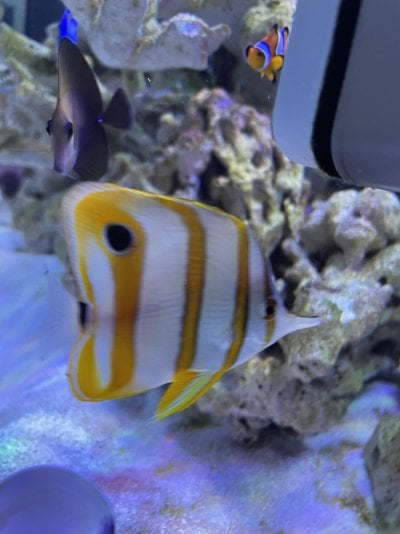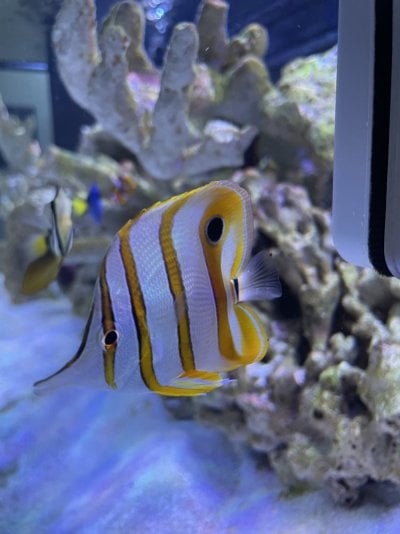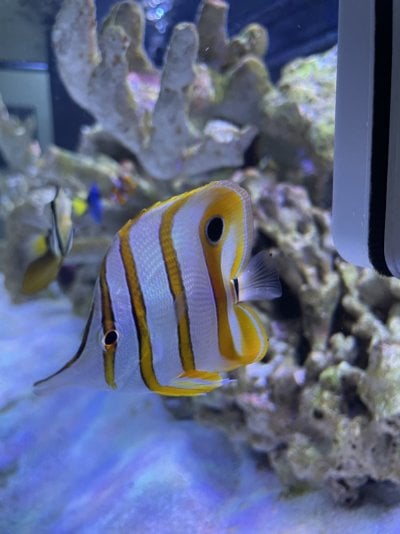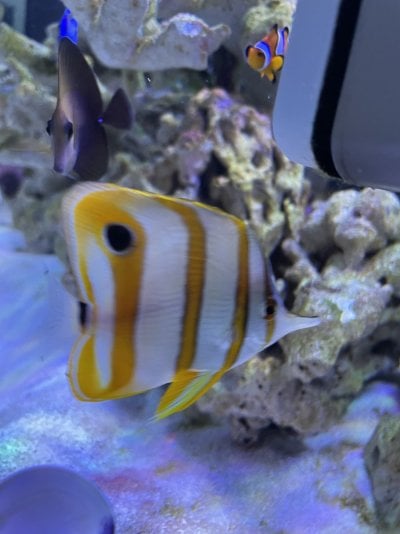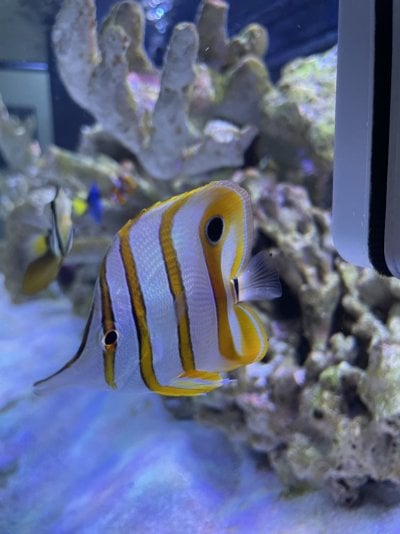I have a copperbanded butterfly in my tank. When i first got him he was completely fine and would eat the clams and swim around but now he is surfing the glass pretty much all day long in one side of the tank. he has these little brown/black spots on the edge of his fins and was wondering what it is and maybe if it’s why he’s surfing the glass. the black/brown looking spots are in the same place that lymphocystis tends to be on the edge of the fins but the spots aren’t white, they’re a brown/black looking color. any ideas on what i should do?
Navigation
Install the app
How to install the app on iOS
Follow along with the video below to see how to install our site as a web app on your home screen.
Note: This feature may not be available in some browsers.
More options
You are using an out of date browser. It may not display this or other websites correctly.
You should upgrade or use an alternative browser.
You should upgrade or use an alternative browser.
CBB with black spots on fins
- Thread starter itsnicholas
- Start date
- Tagged users None
vetteguy53081
Well known Member and monster tank lover
View Badges
Partner Member 2024
Excellence Award
Reef Tank 365
RGB
Article Contributor
Tampa Bay Reef Keepers
West Palm Beach Reefer
Hospitality Award
Ocala Reef Club Member
305 Reef Club
Wisco Reefers
Midwest Reefer
Fish Medic
MAC of SW Florida
Rock Pool Reef Keepers
R2R Secret Santa 2023
My Tank Thread
My Aquarium Showcase
Please post a pic under white light intensity for best identification. Fish may be intimidated by a tank mateI have a copperbanded butterfly in my tank. When i first got him he was completely fine and would eat the clams and swim around but now he is surfing the glass pretty much all day long in one side of the tank. he has these little brown/black spots on the edge of his fins and was wondering what it is and maybe if it’s why he’s surfing the glass. the black/brown looking spots are in the same place that lymphocystis tends to be on the edge of the fins but the spots aren’t white, they’re a brown/black looking color. any ideas on what i should do?
I have a copperbanded butterfly in my tank. When i first got him he was completely fine and would eat the clams and swim around but now he is surfing the glass pretty much all day long in one side of the tank. he has these little brown/black spots on the edge of his fins and was wondering what it is and maybe if it’s why he’s surfing the glass. the black/brown looking spots are in the same place that lymphocystis tends to be on the edge of the fins but the spots aren’t white, they’re a brown/black looking color. any ideas on what i should do?
Can you post a clear photograph taken under white light?
Is the fish still eating well?
Glass surfing can be a stress response, or just a repetitive behavioral activity, but if it interferes with proper feeding (always a problem with this species!) then you need to dive deeper into the issue.
Jay
I assume 'pun intended'. Anyway - I have a comment to glass surfing - I think wild fish seem to do it more - (anxiety, ???). But - I was curious - what is a differential diagnosis of glass-surfing - Is there a specific parasite/disease with this as a symptom ?(always a problem with this species!) then you need to dive deeper into the issue.
No, I don't know of a specific disease associated with this, but it can be from general stress due to any number of diseases. I actually see this more in long term captives - where they develop stereotypic behavior....we have a longnose butterflyfish that has lived in our big reef tank since 2015 - it swims across the tank, reaches a back window, swims up the window, inverts, swims upside down for a few feet, then repeats. It does stop to feed.I assume 'pun intended'. Anyway - I have a comment to glass surfing - I think wild fish seem to do it more - (anxiety, ???). But - I was curious - what is a differential diagnosis of glass-surfing - Is there a specific parasite/disease with this as a symptom ?
There is a whole science of animal behavior designed to try and stop such stereotypic behavior; giving the fish more to do (feeding more frequently) or placing barriers in its way to make it take a different path. I've offered advice to home aquarists to try and block reflections from the glass - I usually say try to black out the glass pane, but I recently had one person tell me that putting a white sheet outside the tank stopped it for them.
Jay
Thanks - interestingNo, I don't know of a specific disease associated with this, but it can be from general stress due to any number of diseases. I actually see this more in long term captives - where they develop stereotypic behavior....we have a longnose butterflyfish that has lived in our big reef tank since 2015 - it swims across the tank, reaches a back window, swims up the window, inverts, swims upside down for a few feet, then repeats. It does stop to feed.
There is a whole science of animal behavior designed to try and stop such stereotypic behavior; giving the fish more to do (feeding more frequently) or placing barriers in its way to make it take a different path. I've offered advice to home aquarists to try and block reflections from the glass - I usually say try to black out the glass pane, but I recently had one person tell me that putting a white sheet outside the tank stopped it for them.
Jay
He’s the biggest one in my tank. You can see the brown spots on the edge of his fins here.Please post a pic under white light intensity for best identification. Fish may be intimidated by a tank mate
Attachments
He doesn’t eat the frozen food I feed. When I put a littleneck clam in, he will eat that for like 5 minutes and then go back to surfing the glass. A week ago he would spend all day eating it pretty much. He will sometimes go back and forth to the clam and the glass. In this picture you can see the brown spots on the edge of his fins.Can you post a clear photograph taken under white light?
Is the fish still eating well?
Glass surfing can be a stress response, or just a repetitive behavioral activity, but if it interferes with proper feeding (always a problem with this species!) then you need to dive deeper into the issue.
Jay
Attachments
Thanks - interesting
Attachments
vetteguy53081
Well known Member and monster tank lover
View Badges
Partner Member 2024
Excellence Award
Reef Tank 365
RGB
Article Contributor
Tampa Bay Reef Keepers
West Palm Beach Reefer
Hospitality Award
Ocala Reef Club Member
305 Reef Club
Wisco Reefers
Midwest Reefer
Fish Medic
MAC of SW Florida
Rock Pool Reef Keepers
R2R Secret Santa 2023
My Tank Thread
My Aquarium Showcase
I see lymphocystis which is typical with these fish and is viral which is a condition and not disease. As for the black dots, I suspect also viral and you will want to focus on both water quality and diet. Other than very slightly thin, fish looks good.He’s the biggest one in my tank. You can see the brown spots on the edge of his fins here.
I see both a scopus tang and sailfin tang and would be both candidates for harassment and intimidation.
He doesn’t eat the frozen food I feed. When I put a littleneck clam in, he will eat that for like 5 minutes and then go back to surfing the glass. A week ago he would spend all day eating it pretty much. He will sometimes go back and forth to the clam and the glass. In this picture you can see the brown spots on the edge of his fins.
I can't tell you what those spots are, but they are inconsequential to this behavior. The change in feeding behavior is the concern here - new CBB always have trouble getting enough food in them to maintain body mass, and the change in feeding is worrisome.
Have you tried any live foods? Live brine shrimp, live black worms?
No clue what the back areas are - I also don't see the lymphocystis - but I assume since @vetteguy53081 does, that its there. Can you remind if you haven't already - mentioning how big the tank and fish are?
Lymphocystis can be white, brown or black. Here is my fish with several spots. It is improving. when I first brough him home a few weeks ago, he had them on tail and both pectoralis fins. Now only on the L pectoralis fin, with one dark spot and two white spots.


Similar threads
- Replies
- 2
- Views
- 72
- Replies
- 9
- Views
- 222
- Replies
- 3
- Views
- 46
- Replies
- 3
- Views
- 108
- Replies
- 5
- Views
- 154






